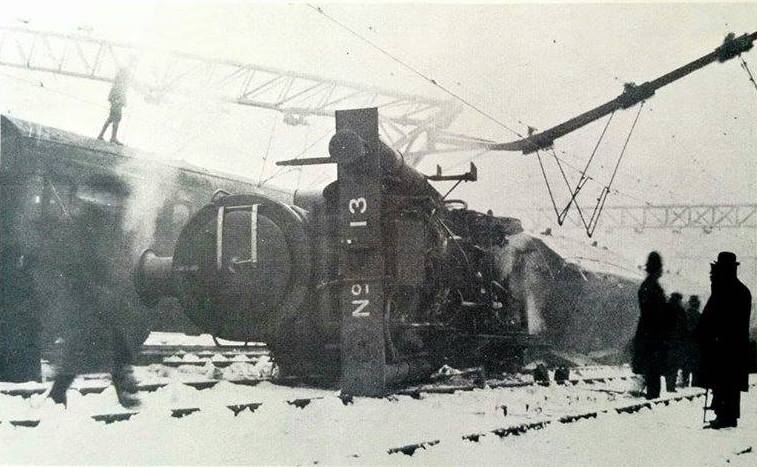
1915
STREATHAM COMMON
23rd JANUARY 1915
Three trains in one crash which
involved two Brighton crews,
and loco crew from unknown depot,
Driver Henry/Harry Funnell (his fireman is not named),
of the 12.5 p.m. down passenger train from Victoria to Brighton
Driver Thomas Godden and his Fireman William Routledge,
of the 9.45 a.m. up passenger train from Brighton to Victoria
Battersea Driver Jack Baignet and his Fireman Edward Booth
of the 6.18 a.m. goods train
extracted & adapted from the Board of Train report
by P.G. Von Dunlop L.T. Col. R.E.

Photo from the book
“The Brighton Line, a pictorial survey”
by Bradford Barton
In this case, as an up goods train, consisting of an engine, four wagons and a brake van, was standing on the up main line between Streatham Common North and South signal boxes, its rear end was run into by the engine of the 9.45 a.m. up passenger train from Brighton to Victoria, consisting of an engine and eight vehicles.
The speed of the passenger train at the time of the collision was between 15 and 20 miles an hour. The engine and one vehicle of the passenger train were slightly damaged, but none of the vehicles of it were derailed. The brake-van and rear wagon of the goods train were practically demolished, and the three other wagons on this train were derailed and considerably damaged; the engine of the train was not, however, damaged at all, nor was it derailed.
Almost immediately after the above collision took place, a down passenger train, consisting of an engine and seven vehicles, arrived on the down main line. The engine of this train ran into the wreckage of the goods train, which was fouling the down line, and the engine and two leading vehicles of that train were derailed; the engine became uncoupled from the train and fell over on to its right side. The engine and leading vehicle of this train were both very considerably damaged, and the remaining vehicles of it were all slightly damaged.
Nineteen passengers have notified the Company of personal injuries sustained, but it is not thought that any of these is of a serious nature. Driver Jack Baigent (depot unknown) of the goods train, however, was unfortunately caught between the down train and the derailed vehicles of his own train, and he was found lying dead near the leading wagon of his train.
The engine of the goods train was a six-wheels-coupled tank-engine, with one pair of radial trailing wheels, and at the time of the collision it was running chimney first; it was fitted with the Westinghouse automatic brake, working blocks on all the coupled wheels, and with a hand-brake working the same blocks. The train consisted of four loaded wagons and a brake van; the latter was a 7-ton, four wheeled van, and it was fitted with a hand-brake working blocks on all its wheels.
Description.
Streatham Common Station near which this accident occurred, is situated on the Victoria-Croydon section of the Company’s main line from London to Brighton. The station, which lies approximately north-west and south-east, has four passenger lines running through it, viz., the up and down main lines on its south side and the up and down local lines on its north side, the up line being in each case on the south side of the down line. The up and down main lines lie between the up platform on the south side of the station and a centrally situated island platform ; it is solely with these two lines that this accident is concerned.
There are two Streatham Common Signal-boxes, viz., the north box situated on the up side of the line at the north end of the station, a few yards to the north of the north end of the station platform, and the south signal-box situated on the up side of the line, 642 yards to the south of the south end of the station platform. These two signal-boxes are 846 yards apart; they are each provided with the usual distant, home, and starting signals for both up and down main lines.